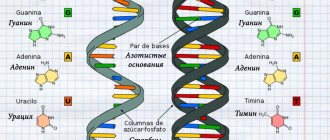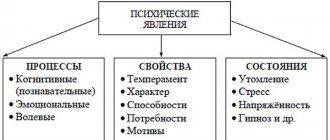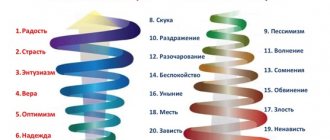Memory is a process occurring in the human psyche, through which material is accumulated, saved and displayed. Memory in psychology is the definition of the brain’s ability to perform the functions of remembering, storing and recreating experience. Also, this mental process allows a person to remember experiences and events of the past, consciously thinking about its value in his own history and comprehend the feelings and emotions that are associated with it. This process allows a person to expand his cognitive abilities. This property also has a complex structure, consisting of several functions and processes that ensure the perception of information from the surrounding reality and its recording in past experience. Internal memory is a complex process in which the perception, accumulation, storage, systematization and very rapid reproduction of information is carried out.
Definition
Memory is involved in processing a huge amount of information. This information takes many different forms, such as images, sounds, or meanings.
For psychologists, the term “memory” covers 3 important aspects of information processing:
- Memory encoding. When information enters the memory system (from sensory input), it must be converted into a form that the system can handle so that it can be stored.
- Memory capacity. How data is stored affects how it is processed in the future. Miller put forward this idea in 1957 and called it the magic number 7. According to him, the capacity of short-term memory was 7-9 items because it only had a certain number of “slots” in which items could be stored.
- Memory restoration. This refers to retrieving information from storage. When a person is asked to retrieve something from memory, the differences between short-term (STM) and long-term (LTM) memory become very clear. STM is stored and retrieved sequentially. LTM is stored and retrieved by the association.
There are 3 main ways to encode (change) information:
- visual (picture);
- acoustic (sound);
- semantic (meaning).
Most memory research is based on experiments conducted in laboratories. Psychologists use the term "ecological validity" to refer to the extent to which research findings can be generalized to other settings.
Memory in psychology (the properties of long-term and short-term memory are still poorly understood) has been tested through experiments. They have high ecological validity if the results can be generalized, applied, or extended to settings outside the laboratory.
It is often assumed that if an experiment is realistic or plausible, then there is a high probability that its results can be generalized. If this is not realistic (if the laboratory conditions and tasks are staged), then the results are less likely to be generalizable across situations.
Kinds
Memory was a subject of study among many 20th century psychologists, and remains an active area of study for modern cognitive scientists:
| Creator | Characteristics of experiments |
| Multiple department model (Atkinson and Shiffrin, 1968) | In 1968, Richard Atkinson and Richard Shiffrin proposed an influential theory of memory known as the multiple compartment model. This model assumes that information exists in one of 3 memory states: sensory, short-term, and long-term storage. Information comes into memory from the senses - for example, the eyes see a picture, the olfactory receptors in the nose can smell coffee or the ear can hear a piece of music. This stream of information is stored in the sensory memory store, and because it consists of a huge amount of data, only a small part of it needs to be remembered. |
| Levels of Processing (Craik & Lockhart, 1972) | Fergus Craik and Robert Lockhart criticized the multicompartment model's explanation of memory, so in 1972 they proposed an alternative explanation known as levels of processing effect. According to this model, memories are not stored in 3 compartments; instead, the strength of the memory trace depends on the quality of processing or rehearsal of the stimulus. In other words, the more a person thinks about something, the longer the memory of it remains. |
| Working memory model (Baddeley & Hitch, 1974) | While the multiple compartment model provided compelling insight into how sensory information is filtered and made available for recall according to its importance, Alan Baddeley and Graham Hitch viewed short-term memory (STM) storage as a complete, simplified phenomenon and proposed a model of working memory , which will replace STM. It relies on two components, the visuospatial sketchpad (inner eye) and the articulatory-phonological loop (inner ear), which focus on different types of sensory information. The visuospatial sketchpad also allows a person to recall and review visual information stored in long-term memory. The articulatory-phonological loop processes sounds and voices that are heard. |
| Miller's Magic Number (Miller, 1956) | Prior to the working memory model, American cognitive psychologist George A. Miller questioned the limits of short-term memory capacity. In a famous 1956 paper published in the journal Psychological Review, Miller referred to the results of previous memory experiments, concluding that people can typically store on average only 7 blocks of information in the short term. Miller realized that the brain is capable of “combining” pieces of information, and these pieces count towards the 7-digit STM block limit. For example, a long word consists of many letters that form numerous phonemes. Instead of remembering a 7-letter word, the mind “recodes” it by combining individual pieces of data. This process allows you to increase your memory limits to a list of 7 individual words. |
| Memory Decay (Peterson, 1959) | Following Miller's "magic number" paper on short-term memory capacity, Peterson decided to measure the longevity of memories. In an experiment using the Brown-Peterson task, participants were given a list of trigrams—nonsense lists of 3 letters (e.g., GRT, PXM, RBZ)—to remember. After the trigrams were shown, participants were asked to count the number and recall the trigrams at different times after memorizing them. Despite the fact that almost all participants could initially remember the trigrams, after 18 sec. The accuracy of the experiment dropped to about 10%. Peterson's research demonstrated the surprising brevity of memories in the short-term compartment of the brain before decay affected the ability to remember them. |
| Flash of Memory (Brown and Kulik, 1977) | When news of the death of a famous person spread throughout the world, people began to “remember” their activities at that moment. Psychologists Roger Brown and James Kulik recognized this phenomenon of memory back in 1977. A person can remember minute details of personal circumstances while participating in other mundane activities. Moreover, you don't have to be personally involved with an event for it to affect people's lives. |
| Memory and smell | The connection between memory and smell helps many species of living organisms survive. The ability to remember and later recognize odors allows animals to detect the nearby presence of members of the same group, potential prey and predators. Researchers at the University of North Carolina tested olfactory effects on memory encoding and retrieval in a 1989 experiment. Male college students were shown a series of slides of photographs of women whose attractiveness they were asked to rate on a scale. Results showed that participants were better able to recall memories when the odor during encoding was the same as the odor during revision (Cann and Ross, 1989). These results suggest that the connection between the sense of smell and memories is conserved. |
| False Memories | This idea may sound like the stuff of dystopian science fiction, but evidence suggests that memories a person already has can be manipulated long after they are encoded. If a group of people is shown a video with a tragic ending, he will definitely name the culprit, based on the thoughts that he has formed within his brain activity. |
Memory in psychology, the properties of which explain the process of encoding and storing information, can be divided into several types. Depending on the type of brain process, people use recently acquired information or old information that has been stored for several years.
Processes
People first process stimuli through their sensory memory—this information is typically stored in the brain for less than a second. The information is then transferred to short-term memory, or working memory, which allows you to think things through and store key points in your mind. Finally, past events enter long-term memory (episodic or semantic).
Different areas of the brain influence aspects of memory.
For example, the hippocampus is associated with spatial memory, which helps the brain map the world around it and bypass negative emotions:
- To form new memories, information must be converted into a usable form, which occurs through a process known as encoding. Once information has been successfully encoded, it must be stored in memory for later use. Most of this stored memory lies outside of consciousness most of the time, except when you really need to use it. The retrieval process brings stored memories into the conscious part of the brain.
- Sensory memory is the earliest stage of information processing. At this stage, sensory information from the environment is stored for a very short period of time, usually no more than ½ second. for visual information, and 3 or 4 sec. for auditory information. Short-term memory, also known as active memory, is information that a person is currently aware of or thinking about. In Freudian psychology, this memory is called the conscious mind.
- Paying attention to sensory memories generates information in short-term memory. Most of the information stored in active memory will be there for about 20-30 seconds.
- Long-term memory refers to the permanent storage of information. In Freudian psychology, long-term memory can be called preconscious and unconscious. This information is largely beyond comprehension, but can be transferred into working memory and used as needed. Some of this information is quite easy to remember, while other memories are much more difficult to access.
Clustering is used to organize related information into groups. Information that is categorized becomes easier to remember and recall.
How to develop a good memory
It is clear that it is voluntary memory that should be developed, since involuntary memory exists without the participation of our consciousness. There are a large number of mnemonic techniques, the first of which were developed in ancient times. However, most people know only about some of these techniques, the simplest and most basic ones, which are not effective enough. For example, repeated repetition of information. In this case, more than half of the necessary information is lost, and such a technique requires quite a lot of time and effort.
Other techniques give a higher memorization effect, here are some of them
:
- Finding unusual associations in remembered objects and events.
- Rhyming words, including composing full-fledged poems.
- Memorizing new words by consonance with already known ones.
- “Roman room”: each memorized object is mentally assigned a separate place in a room well known to the person.
- Letter code: a separate word or phrase is formed from the initial letters of memorized words. There are other options: the initial letters of each word in a sentence are associated with elements of memorized information (as in phrases for remembering the colors of the rainbow such as “Every Hunter Wants to Know Where the Pheasant Sits”).
The letter code is a fairly ancient way to remember the necessary information. According to one version, this is how the names of the Cyrillic letters that make up the mnemonic text were given: “Az, Buki, Vedi, Verb, Dobro...” - that is, “I know the letters, the word good is...”, etc. Letter codes have long been used in encryption.
A fairly old way of memorizing letters is to understand them as pictures of various objects. Actually, at first the letters were drawings - hieroglyphs, which later acquired a sound meaning (for example, according to the first letter of the signified: the Phoenician drawing meaning “bet”, that is, “house”, eventually turned into the letter “b”). Subsequently, the letters of modern alphabets lost their connection with the drawings of objects, but human imagination, especially children's, again endowed them with such associations. And this, in particular, was used by the 17th century Russian writer Karion Istomin when he compiled his famous illustrated primer: the letters in it are presented in the form of images of people and animals in different poses, plants, and entire scenes.
Characteristics and properties
Memory in psychology is divided into short-term and long-term. These are the 2 main types that should be analyzed for common characteristics.
Their properties also depend on the following criteria:
- Brief duration that can last up to 20 seconds.
- Its capacity is limited to 7 ± 2 “portions” of independent information (Miller's law) and is vulnerable to interference and interruptions.
- The fading of such memory occurs while taking medication or as a result of injury.
Short-term memory is responsible for 3 operations:
- Visual interpretation, which is the ability to store images.
- Acoustic imagination, which is the ability to store sounds.
- Working memory, which is the ability to store information before using it.
Information in long-term memory is stored as a network of schemas, which are then converted into knowledge structures. That is why a person remembers relevant knowledge when he comes across such information.
There are 2 types of long-term memory:
- Explicit: conscious memories that include perceptions of the world as well as one's own personal experiences.
- Implicit: unconscious memories that have been used without awareness.
Long-term memory is responsible for 3 operations:
- Coding, which is the ability to transform information into a knowledge structure.
- Storage, which is the ability to accumulate pieces of information.
- Search, that is, the ability to remember things that are already known to a person.
Setting tasks for a person provokes memorization - a work plan, further memorization and use of acquired skills. According to S. L. Rubinstein, memory helps to remember moments that depend on the situation in which they were remembered. And the research of P.I. Zinchenko proves that the mindset of memorization is a direct goal for the action of the brain.
If information is remembered by itself, then a person will better use brain data. Random memorization of pictures and telephone numbers indicates that the brain is not afraid of the tasks assigned to it. Otherwise, if you are forced to learn a poem, a person will be more difficult to succumb to this process.
A. A. Smirnov's research was devoted to the main problem of memorization. Productive unconscious thinking was analyzed during the experiment. Specific conditions were created in which a person remembered all the details of the events taking place, but he was not asked to do so.
Under the same conditions, he was given the task of learning the rules of the organization, which he failed to do. These exercises made it possible to introduce a process of analyzing situations into the education system so that workers and students could quickly integrate into the process of ongoing actions.
Memory in psychology. Properties
Psychologist Ebbinghaus studied the volume of such memory and came to the conclusion that it is easier for a subject to remember 5-7 words of unknown meaning. “Clean” memory produced a result that was ½ less than the initial one. However, several days later the person did not remember a single word.
This experiment gave rise to a new definition - mechanical and meaningful memorization:
- In the first case, mechanical actions are aimed at ensuring that a person remembers which foot he took a step from in order to repeat it in the future. This principle helps to work with athletes. The connection of neurons allows you to scroll through information in your head, which then “works” for the result. Complex elements in sports were performed as refined movements, thanks to the fact that a person “played out” their execution technique several times in his head. The deceived brain thought that the human body could work in this direction.
- Meaningful memorization involves isolating the main and important information from the pure flow of knowledge. This technique is still used in theories and practices at universities. When giving a lecture, the teacher points out important points that need to be remembered. They allow students to build on them, developing thoughts to specific events. They, in turn, remain in the unconscious part of memory. When you need to use data, the brain “opens” the door to it.
- The logical combined method of memorization was founded by M. N. Shardakov, who provided people with the opportunity to remember events evenly and in the required sequence. If the chronology of information reproduction was violated, the memorization tactics changed. The goal of the task was for children and adults to learn information in doses, remembering it in full. No one was able to learn entire poems without fragmentation, despite attempts to convey sounds through music.
The combined type can be used to learn a foreign language. The unconscious and logical method allows you to remember the theory and apply it in practice, while the intentional (force) method practically does not produce results.
Memory in psychology
Memory in psychology is the definition of a person’s ability to remember, retain, reproduce and forget information from his own experience. This property helps a person move in space and time. There are different psychological theories that have their own view of this concept.
In associative theory, the key concept is association. In memory, it connects parts of the perceived material. When a person remembers something, he begins to look for a connection between these materials and those that need to be reproduced. The formation of associations has patterns: similarity, contiguity and contrast. Similarity is manifested in the fact that the material that is memorized is then reproduced through connection with similar material. Contiguity occurs when incoming material is remembered in relation to previous material. The contrast is expressed in the fact that the material that should be remembered is different from that which is retained.
According to behavioral theory, special exercises help memorize material. Such exercises help to better and faster fix attention on objects and episodes. Several factors influence quality memorization: age, individual characteristics, interval between exercises, volume of material and others.
In cognitive theory, this process is characterized as a certain set of blocks and processes of transformation of information material. Some blocks ensure recognition of the expressive features of the material, others create a cognitive orienting map of information, with the help of others, information is retained, and the fourth block transforms the material into a specific form.
Activity theory considers this process as an active component of the connection between a person and the world. This occurs through the processes of analysis, synthesis, grouping, repetition and identification of features; with their help, a mnemonic image is also created, a unique form of material in which a person’s personal attitude lies. Memorization is also influenced by external stimulus signs, which later become internal and the person, guided by them, controls this process.
Functions and role
Memory in psychology (memory properties are directly related to its role and functions performed by it) is divided into several types depending on the functions performed in a person’s life:
| Function | Peculiarity |
| Reflective | Memory is capable of reflecting events that are stored in it in order to remind a person of the consequences. Here we can give an example of “déjà vu,” when a person remembers a number of situations and the moment of his behavior under certain circumstances. |
| Regulatory | I. P. Pavlova in her research talks about associations that help establish strength between events of different times. |
Modern science in the works of P.K. Anokhin explores hypotheses about the mechanism of memory. Biocurrents that are independently renewed in nerve cells help create the effect of visual perception. This is an experiment conducted by P. P. Blonsky, which is based on a mental phenomenon. The act of cognition of a situation occurs due to orientation in the information in the depths of the brain.
The role of memory in human life occupies a dominant niche in the work of the nerve endings of the cerebral cortex. A lawyer must remember the information of all persons participating in the process, a lawyer must remember the theory and veracity of situations. A simple worker must determine the logic of sequential actions. In science they distinguish:
| Explicit memory | Refers to knowledge or experience that can be consciously remembered. |
| Episodic and semantic | Episodic memory refers to the immediate experience that has been acquired. Semantic memory refers to knowledge of facts and concepts about the world. |
| Implicit memory | Implicit memory refers to the influence of experience on behavior, even if the person is not aware of these influences. |
| Procedural memory | It refers to the often inexplicable knowledge of how to do something. For example, make tea or open the door. |
There is another type of implicit memory - these are effects that help to effortlessly reproduce what neutral stimuli in the brain help us remember through associations. A person may unconsciously turn towards a sound or bright light.
Violations
Memory in psychology, whose properties are also uncontrollable events and their consequences, can be subject to minor and serious failures:
- Forgetting is a surprisingly common event that can occur for a number of reasons, including failure to remember a period of time.
- Dementia also affects thinking, judgment and behavior (Alzheimer's disease, progressive supranuclear palsy, normal pressure hydrocephalus, Creutzfeldt-Jakob disease).
- Brain infections (Lyme disease, syphilis or HIV) can cause complete amnesia.
- Parkinson's disease or Huntington's disease (multiple sclerosis) lead to the destruction of connections between neurons.
To identify the likelihood of mental disorders at an early stage, it is necessary to conduct a diagnosis.
Classification of main types of memory
Low self-esteem in a person from a psychological point of view
Basic types of memory
Classification of memory in psychology occurs according to three main criteria:
- By mental activity:
- motor;
- figurative;
- emotional;
- verbal-logical.
- By the nature of the connection:
- involuntary;
- arbitrary.
- By storage duration:
- short-term;
- long-term;
- operational;
- sensory.
To determine the types of memory in different people, special testing is used in psychology.
In addition to the main types, there are other varieties:
- genetic;
- autobiographical;
- reconstructive;
- reproductive;
- episodic;
- iconic;
- echoic.
These are intermediate subspecies between the main ones.
Diagnostics
To diagnose mental and psychological characteristics of memory, testing is carried out:
- A. R. Luria - “learning 10 words.” The purpose of the experiment is to test the level of memory development.
- The method of “determining short-term memory” developed by G.I. Nevelskoy makes it possible to determine the accuracy and identity of memorization. In the experiment, individuals are given numbers arranged randomly. They need to be reproduced orally or in writing at the required speed.
- Testing “visual memory” using I. Melnikov’s method involves proofreading the story. The subject must write down the words that he remembers. The level of auditory memory is assessed in the same way.
Diagnostics can be carried out in Moscow at the Gerontological Clinical Center, at the Center for Psychological Diagnostics and at the Clinical Psychiatric Hospital. The procedure may be repeated depending on the accuracy and purity of the experiment. If the results are not obtained, a repeat examination is carried out. The cost of testing can vary from 2300 to 8900 rubles.
Connections with other sciences
Since memory is a psychophysiological process, during experiments it is necessary to monitor brain activity and other physiological reactions. Therefore, psychologists work in expert groups with scientists from other fields:
- physiologists;
- neurologists;
- psychiatrists;
- neurosurgeons;
- gerontologists;
- defectologists.
The research results are used to develop methods for treating memory disorders and developing memory abilities.
Management methods
Methods for implementing memory functions may imply specific events and actions that are set as a task for the subject.
Mnemonic technique
The essence of the method is to use local binding of verbal intermediaries and divide them into groups.
A person learns a number of elements, compares them and remembers them. J. Bruno developed a methodology to establish the ability to interpret the result obtained in the study. A mnemonic technique allows you to teach a person to evaluate the brain’s ability to hide useless information.
Association method in neural networks
The technique was developed by P.I. Zinchenko. The point is that a person should be able to assemble objects using associative thinking, remembering their role in a person’s life. For example, you need to connect a number of useful actions, correlating their functions to a number of objects. Thus, a person remembers more words, interpreting the result through memories in action.
Flying technology for forgetting and suppressing memories
It was developed by O. L. Podlinyaev, who forced mentally ill people to forget about past negative events in life.
The goal of the technique is to be able to manage the long-term part of memory in the context of neural networks. Suppression of obsessively traumatic events occurs through writing a “burning letter”, emotions that were caused in the past years, and burning emotional complexes.
This technique can involve people in whom simple memory plots cause disturbances in consciousness. For example, a person cannot come to terms with the loss of a loved one and reacts negatively to fire (the fire claimed the lives of relatives). The technique allows you to “let go” of memories and suppress their reaction to the current event (bonfire, burning candle) by burning the sheet on which the emotions are written.
Harris's Mnemonic Devices (1980)
Harris once created an amazing methodology for memory training. The method helped people remember so quickly and store information in the sensory and short-term memory sections for a long time that they inevitably became targets for others. They were able to memorize a deck of cards and magician's techniques, which is why they were considered scammers.
Harris was unable to debunk the myth about these people, since he only created a technique for memory training. To manage such possibilities and learn to suppress rapid memorization syndromes, mnemonist Shereshevsky created synesthesia, which helped disrupt the process of information exchange in the sphere of the phenomenal technique of memorizing everything around.
The essence of the method was that when one area of the brain is irritated, impulses characteristic of the work of another area are activated. Thus, having pushed a person into the abyss, he should not be confused, but rejoice.
This substitution of impulses in the functioning of neurons helped Shereshevsky associate numbers and words with images of people. He also created a technique for forgetting this technique, returning a person to the body’s usual reactions.
Having managed to change the properties of all parts of memory, Shereshevsky created a psychological weapon with which he could control memory. In psychology there are many methods that allow you to manage emotions, thoughts and associative thinking. By studying and interpreting the workings of these parts of the brain, it is possible to control a person and manipulate his feelings to treat diseases.











